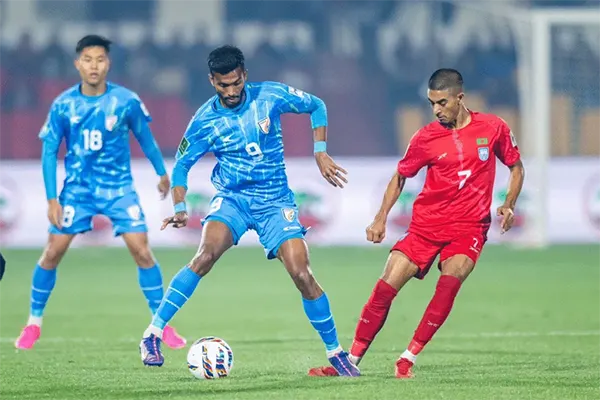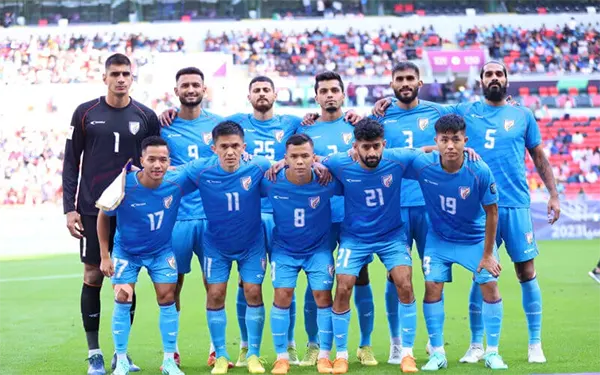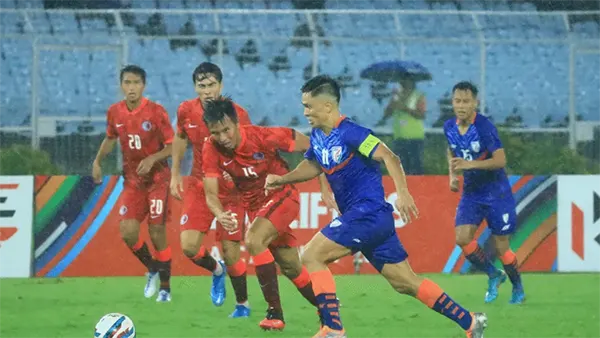
Bangladesh vs Hong Kong – AFC Asian Cup Qualifier
Two teams with opposing rhythms meet with the same goal: to secure points, maintain momentum, and refine methods. Bangladesh frequently compresses the pitch, attacks with the second ball, and relies on quick surges from wide areas.
Hong Kong encourages dense circulation, patient progression, and late-arriving runners. The game should come down to who controls the tempo in the middle third and who manages defensive spacing better after turnovers.
For viewers tracking in-match trends on the Mostbet App, the key indicators will be recoveries, territorial gain after clearances, and the timing of line breaks. That’s why in this blog post, we are going to cover numerous insights about the match analytics and how they affect the overall standings
Let’s begin!
Key Takeaways
- Understanding the match background
- Uncovering some crucial match details
- Looking at some pivotal team previews
- Discovering their history of rivalry
- Exploring some tactical issues
Match Background
Before starting anything let’s talk about the match background analysis of both the teams to get clarity about their past performances and competitive edge.
Significance in the 2027 AFC Asian Cup qualification
Every window in this cycle favors consistency over spectacle. A win here strengthens the winner’s advantage in tie breaks and cushions the inevitable dips later in the campaign. In practice, this means more freedom to rotate during busy weeks and less scoreboard pressure against top-seeded opponents.
Psychologically, the fixture offers proof of concept: Bangladesh test their higher press against a structured block; Hong Kong verifies that their buildup resists vertical traps.
Interesting Facts
The minimum and maximum salaries of professional footballers back in 2009 were BDT 50,000 and BDT 10,00,000 respectively.
Group standings leading up to the match
The group’s composition has emphasized discipline. Even minor sequences, such as restarting quickly after a stoppage, defending throw-ins with focus, and clearing the near-post zone on corners, have shaped margins.
Coming into this match, both teams are in a bracket where a single win could reorder the table. Goal difference, head-to-head points, and set-piece conversion rates may ultimately separate contenders from chasers.

Match Details
Minor details play a very crucial role in every game, and in decider matches like these ,the minor information becomes more serious. Let’s see how they impact.
Date, Time & Venue
Fixture specifics are typically assigned within FIFA international windows. Expect an evening kickoff local time to suit broadcast and attendance. The venue selection often balances pitch condition, travel logistics, and training access.
Teams will prioritize a surface that allows for clean passing while minimizing unpredictable bounces, which is particularly important for Hong Kong’s buildup and Bangladesh’s timed runs beyond the line.
Ticketing & Fan Information
Allocation usually follows federation guidance: home sections, a contained away block, and family areas. Supporters should anticipate standard stadium screening, cashless concessions where available, and staggered entry times to reduce queues.
Match day stewards typically regulate choreography, banners, and percussion, so plan your displays accordingly. Even if the event begins in the evening, hydration and sun protection are important for daytime attendees.
Team Previews
Now let’s take a look at the most crucial part, which is none other than team comparisons and their distinctive previews
Bangladesh — form, strengths, key players
When Bangladesh puts the midfield trigger, forward pass, center back touch, or sideline trap, which releases play onto the full back, all are made at once. Their strengths include aerial duel strength, eagerness for second balls, and, with set-pieces, usually aimed at the near-post flick or congested far-post charge.
Key figures often include a tigerish center-half who attacks first contact, a tireless ball-winning midfielder, and a direct out-and-out winger capable of carrying forty yards down the touchline to remove pressure.
- Effective Measures: Quick restarts, free-kicks hit for goal and long balls to dump it back at the full-back to face a 1-vs-1 situation.
- What Is Missing: Short passing out from the back when under heavy opposition pressure, and spatial arrangements behind their own goalmouth on corners.
Hong Kong — recent performance, star players
Hong Kong’s best spells arrive through patient circulation that draws a press before piercing it with a vertical punch. Expect a double pivot rotating to receive on the half-turn, full-backs stepping inside to help overload midfield, and a winger who inverts to connect. Their star profiles tend toward a precise set-piece taker, a metronomic midfielder, and a center-back comfortable defending space when the line steps high.
- What works: controlled tempo, coordinated counter-press, delayed runs into the box.
- What must improve: defending second phases after clearances and closing the far-post lane on crosses.

Head-to-Head History
The discussions and meeting sessions have been succinct, focused on initial objectives and structured execution. Let us examine them:
Past results and trends between these teams
Recent meetings have been brief, driven by initial objectives and set-piece execution. Bangladesh frequently attempts to turn the duel into a physical battle, whereas Hong Kong prefers to extend possessions and wait for positional errors.
Draws have occurred when neither team converts early pressure. When momentum swings, it typically starts in midfield duels: win the loose balls, and territory follows; lose them, and the block gets pinned.
Tactical Outlook & Predictions
In every game, the enthusiasm for tactical outlook and prediction is on another level. Let’s cover them one by one
Expected lineups & key matchups
Expect Bangladesh to resemble a 4-2-3-1 that behaves like a 4-4-2 out of possession: the “10” jumps to the pivot, wingers track full-backs, and the back line compresses vertically. Hong Kong may employ a 4-3-3 formation that transitions to a 2-3-2-3 in the buildup: the full-backs invert, one midfielder anchors, and the front line rotates to unpin the center-backs.
Key matchups
- Who dictates passing angles: Bangladesh’s ball winner or Hong Kong’s controller?
- Bangladesh’s right winger vs Hong Kong’s left-back: can isolation yield entries into the box?
- Aerial duels on set-pieces: first contact will define second-phase chaos.
Compact Comparison
| Aspect | Bangladesh | Hong Kong |
| Typical Shape | 4-2-3-1 → 4-4-2 out of possession | 4-3-3 → 2-3-2-3 in buildup |
| Primary Strength | Set-pieces, second balls, vertical surges | Tempo control, positional rotations |
| Risk Zone | Transitions after attacking corners | Far-post crosses, long-ball second phases |
| Chance Creation Path | Early crosses, knockdowns, long diagonals | Third-man runs, inside-channel combinations |
Prediction and factors to watch
Given the styles, a low- to mid-scoring match is possible. If Bangladesh wins the restart battle and maintains consistent deliveries, they will force defensive scrambles.
If Hong Kong escape the first press and advance with the ball carried centrally, they can create clean looks with cut-backs. Discipline around minute 60–75—when legs fade and shapes loosen—may decide it.https://guidebook.mostbet.com/registration/

Projected edge: Slight lean toward a draw, with late set-pieces the most likely differentiator.
Swing factors
- Game-state: First goal magnifies control; chasing teams must risk line height.
- Set-piece detail: Screens, starting positions, and blockers at the keeper.
- Bench impact: Fresh wide runners against tiring full-backs.
Broadcast & Live Coverage
Broadcast rights usually belong to national federations or regional entities. Media coverage often includes terrestrial broadcasters, pay-TV, and official digital channels.
Channels & streaming
Normally, rights belong to a country’s national federation or a region where services can be provided. Depending on where you see the ball booted around, the media in question typically ranges from terrestrial broadcasters, pay-TV companies, or the event’s official digital channels.
There are invariably pre-match shows rather than post-match chat as well as half-time segments followed up with action replays. Pre-match shows almost always feature tactical boards and interviews with players; halftime segments tend to focus on presentations of set-piece breakdowns and pressing heat.
Live updates and commentary options
For the more mobile fan following India vs Pakistan: September 2025, live text feeds matching moves minute by minute together with official social updates will generally bring you, unchanged, team sheets, tactical adjustments so far, and what was happening x minutes ago.
Their impartial commentary tends to emphasize pressing traps, overloads, and midfield reference-point changes caused by substitutions. Following the final whistle, post-match reports should include a brief but focused analysis of expected goals from open play versus set-pieces and transitions made by either team.
Ans: The national football team of Bangladesh made its inaugural appearance in 1973 and has not yet achieved qualification for the FIFA World Cup finals.
Ans: Kai Tak Sports Park in Kowloon.
Ans: Bangladesh remains in 184th position in the FIFA ranking.










